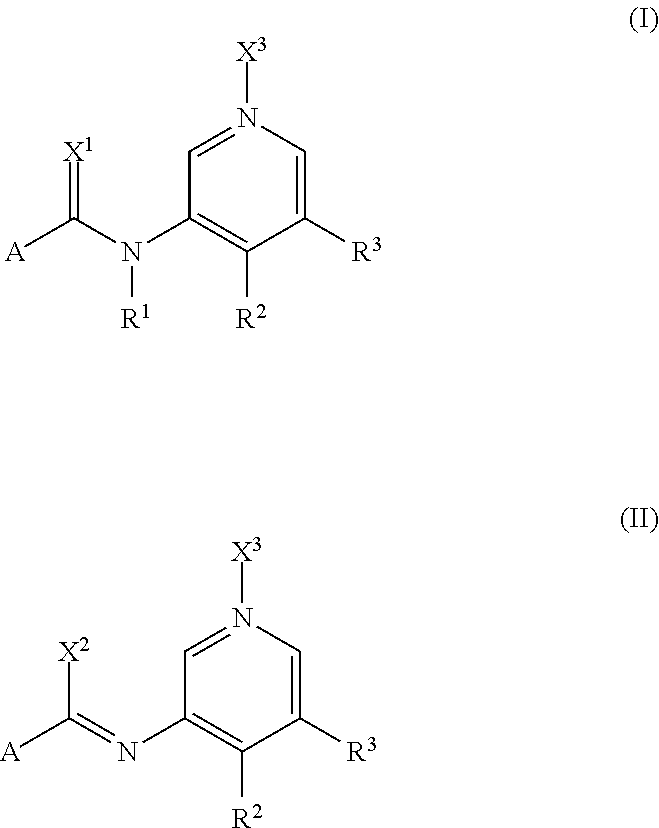Pyridine Derivatives Compounds for Controlling Invertebrate Pests
a technology of invertebrate pests and derivative compounds, which is applied in the direction of antiparasitic agents, biocides, drug compositions, etc., can solve the problems of large economic loss to food supply and property, inability to readily obtain cross-breeding, and granules to be applied undiluted for foliar application
- Summary
- Abstract
- Description
- Claims
- Application Information
AI Technical Summary
Problems solved by technology
Method used
Image
Examples
example 15
3-Cyclopropyl-isoxazole-4-carboxylic acid pyridin-3-ylamide
3-Cyclopropyl-isoxazole-4-carboxylic acid
[0507]5.6 g (31 mmol) of 3-Cyclopropyl-isoxazole-4-carboxylic acid ethyl ester were slowly added to a solution of 6.1 g (93 mmol, 85% purity) of potassium hydroxide in ethanol / water (1:3, 100 ml) at 0° C. The reaction mixture was stirred at room temperature for 16 h, diluted with water, acidified (pH=2) with 20% aqueous HCl and extracted with dichloromethane. The combined organic layers were dried over sodium sulfate, filtered and the solvent was removed to yield 4.7 g (94%, 95% purity) of the title compound which did not need further purification.
3-Cyclopropyl-isoxazole-4-carboxylic acid pyridin-3-ylamide
[0508]400 mg (2.6 mmol) of 3-cyclopropyl-isoxazole-4-carboxylic acid were suspended in 10 mL of toluene and one drop of dimethylformamide was added to the mixture. 0.24 mL of thionylchloride (3.3 mmol) were added at room temperature and the reaction mixture was stirred at 65° C. for ...
example 2
5-Br-thiazole-4-carboxylic acid pyridin-3-yl-amide
[0509]150 mg (0.43 mmol) of 5-bromo-thiazole-4-carboxylic acid and 81.4 mg (0.87 mmol) of pyridin-3-yl-amine were dissolved in 6 ml dimethyl formamide. 0.09 mL (0.65 mmol) of triethyl amine followed by 225 mg (0.43 mmol) of 1H-benzotriazol-1-yloxytri-pyrrolidinophosphonium hexafluorophosphate (PyBOP) were added and the reaction mixture was stirred at room temperature for 16 h. Brine was added and the reaction mixture was extracted two times with dichloromethane. The combined organic layers were dried over sodium sulfate, filtered and the solvent was removed under reduced pressure. The obtained residue was purified by flash column chromatography (silica, gradient elution cyclohexane→ethyl acetate→methanol) to give 90 mg (66%, 90% purity) of the title compound.
[0510]Compounds of formula (Ia) prepared according to the above mentioned method together with their physico-chemical data are compiled below. R1 and A in each case have the mean...
PUM
| Property | Measurement | Unit |
|---|---|---|
| temperature | aaaaa | aaaaa |
| temperature | aaaaa | aaaaa |
| v/v | aaaaa | aaaaa |
Abstract
Description
Claims
Application Information
 Login to View More
Login to View More - R&D
- Intellectual Property
- Life Sciences
- Materials
- Tech Scout
- Unparalleled Data Quality
- Higher Quality Content
- 60% Fewer Hallucinations
Browse by: Latest US Patents, China's latest patents, Technical Efficacy Thesaurus, Application Domain, Technology Topic, Popular Technical Reports.
© 2025 PatSnap. All rights reserved.Legal|Privacy policy|Modern Slavery Act Transparency Statement|Sitemap|About US| Contact US: help@patsnap.com



